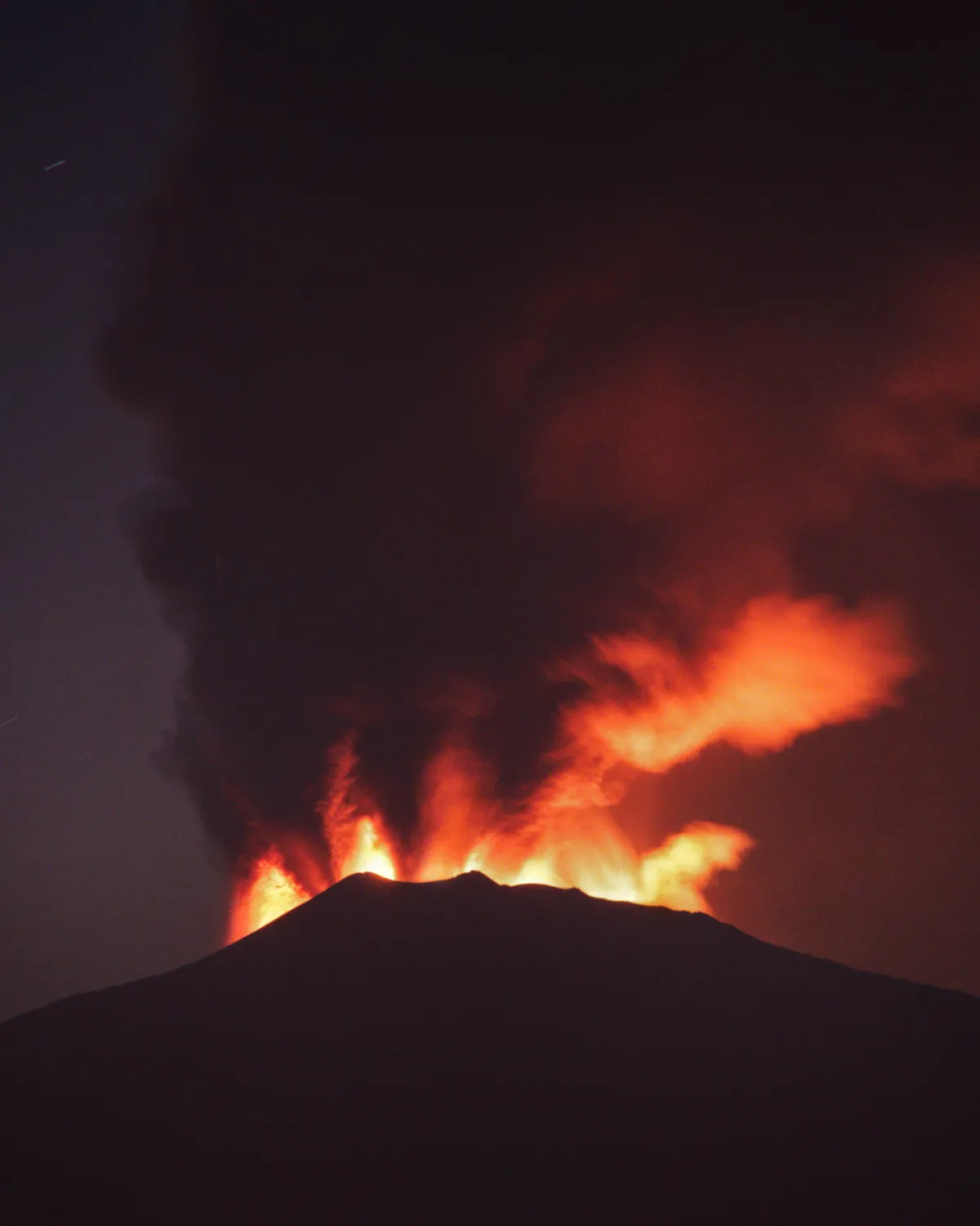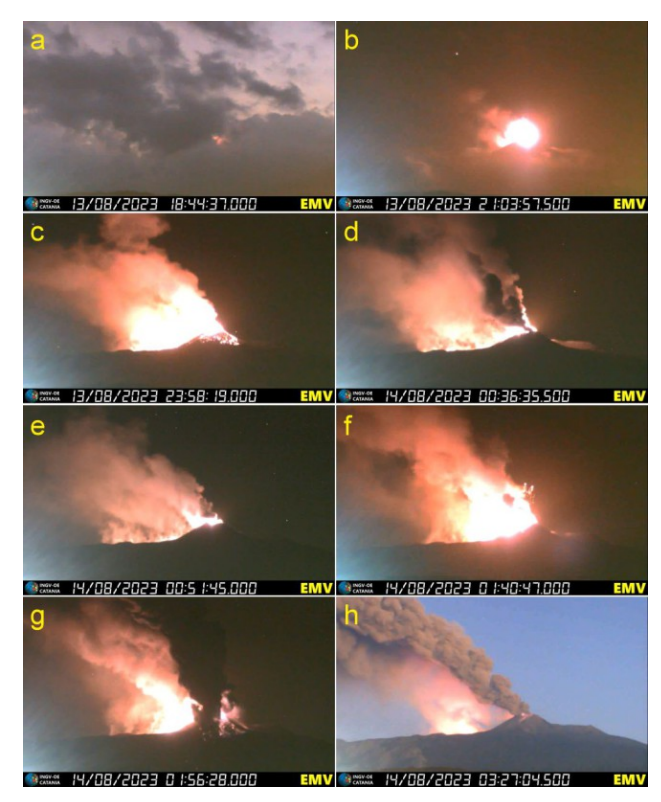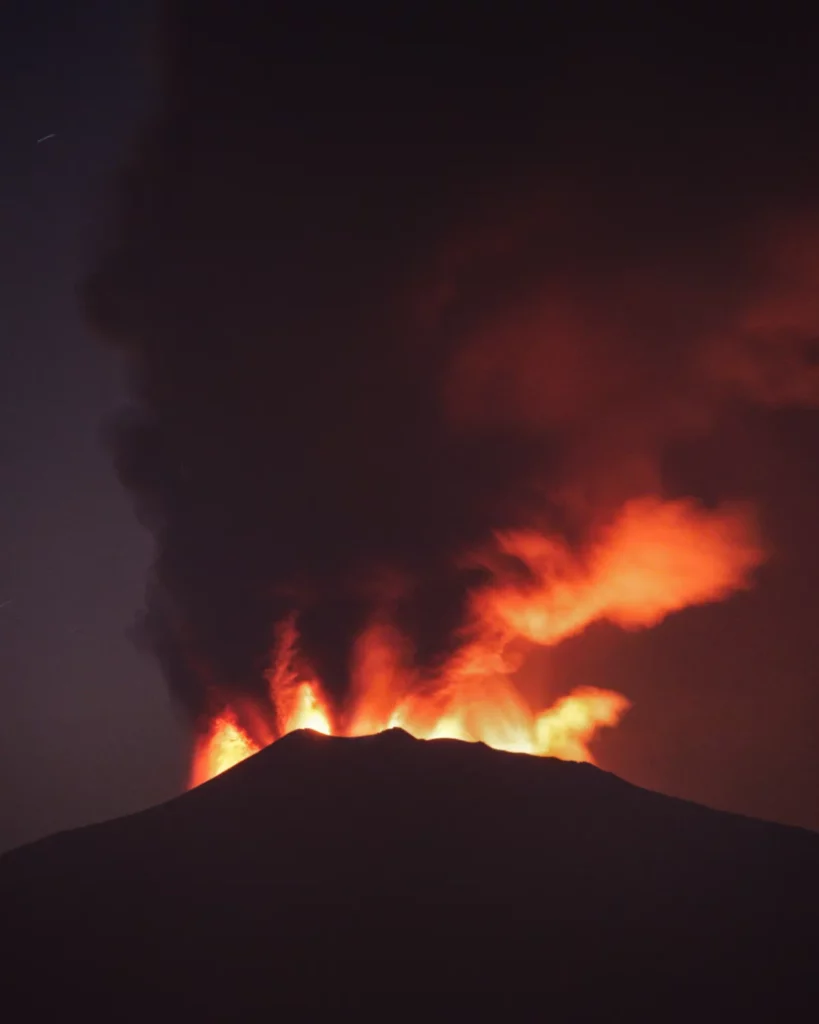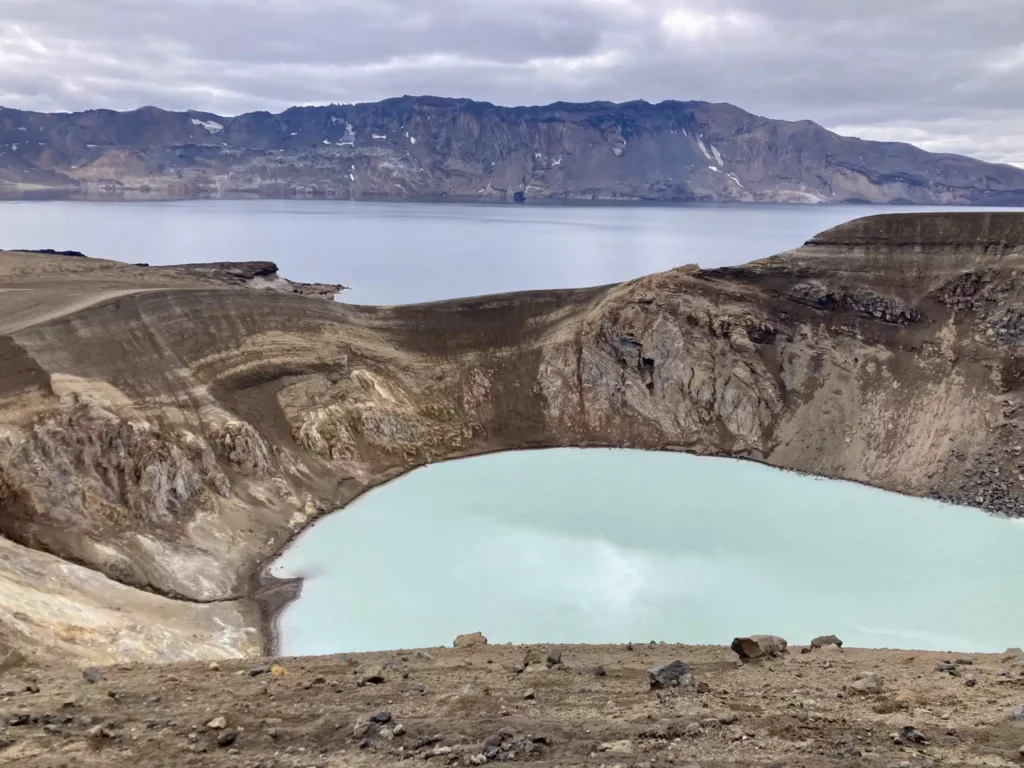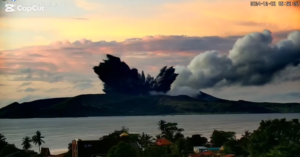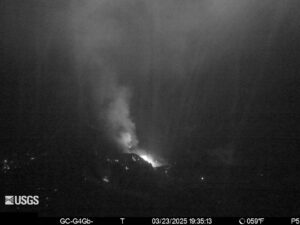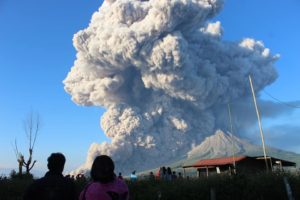August 18 , 2023.
Italy / Sicily , Etna :
WEEKLY BULLETIN, from August 08, 2023 to August 14, 2023, (issue date August 16, 2023)
ACTIVITY STATUS SUMMARY
In the light of the monitoring data, it is highlighted:
1) VOLCANOLOGICAL OBSERVATIONS: Degassing activity of the summit craters, in particular the Bocca Nuova and Southeast craters; paroxysmal episode at the Southeast Crater on the night of August 13-14.
2) SEISMOLOGY: Very weak seismic activity of fracturing. Regarding the volcanic tremor, apart from the high values recorded in the last hours of the 13th during the paroxysm at the Southeast Crater, its average amplitude has always remained within the range of average values.
3) INFRASOUND: Weak infrasound activity for most of the week, with a marked increase in activity during the paroxysm at the Southeast Crater.
4) GROUND DEFORMATIONS: During the last week, the ground deformation monitoring networks have not recorded any significant variations. On the 13th from 21 UTC the stations of the inclinometer network recorded variations in correspondence with the lava fountain episode of August 13-14.
5) GEOCHEMISTRY: SO2 flux at an average level
CO2 fluxes show a sharp drop, reaching medium-low values.
Isotope ratio of helium on high values.
The partial pressure of dissolved CO2 does not show any significant variations.
6) SATELLITE OBSERVATIONS: Thermal activity in the summit area was high to very high during lava fountaining on August 13-14, 2023.
The new « Pit » in detail, the « collapse crater » formed last July 17 inside the Bocca Nuova crater
VOLCANOLOGICAL OBSERVATIONS
During the week of August 7 to 13, the monitoring of Etna’s activity was carried out through the surveillance cameras of the INGV – Osservatorio Etneo (INGV-OE), supported by observations
carried out during the various inspections carried out by INGV-OE staff in the summit area.
From August 7 until the evening of August 13, the activity at the level of the summit craters of Etna was characterized by the usual degassing, in particular of the crater of Bocca Nuova (BN) and the Southeast crater (CSE ). As in previous weeks, degassing at BN-1 was pulsed, often in « puffs » of dense vapor accompanied by loud booms, at 5-10 minute intervals. The vent immediately east of BN-1 showed very weak degassing. The mouth that opened on July 15 in the southeastern part of Bocca Nuova was the site of continuous and strongly pulsating degassing.
Characteristically, a series of puffs of gas with modest amounts of fine ash occurred, alternating with the « sucking » of gas into the flue. This pulsating outgassing generated numerous vapor rings. At the Southeast Crater (CSE), degassing continued from the east vent and numerous fumaroles located along the crater rims. There was also a fumarole at the mouth of the « old » CSE cone, which emitted bluish gas. This fumarole was first observed in mid-July and has gradually become more visible since then.
At the Voragine crater, several areas of fumarolic activity were observed, particularly on the eastern and southwestern edges, while on the intra-crater cone, there were large areas covered with fumarolic deposits. The northeast crater, on the other hand, showed modest fumarolic activity from an area of the lower northwest inner wall.
The August 13-14, 2023 peak in Milo Visual Surveillance Camera (EMV) images, showing the different stages of activity, from initial growth (a,b), to fluctuations in intensity (c, d,e) at the peak with high jets (f) and pyroclastic flows (g) and ash emission at the end of the paroxysm.
PAROXYSM OF AUGUST 13-14, 2023
At dusk on August 13, around 6:40 p.m. UTC, in correspondence with a sudden increase in the amplitude of the volcanic tremor, through short openings in the cloud cover, eruptions were seen at the CSE. Activity rapidly intensified from Strombolian activity to lava fountaining about 300-400 m high above the crater.
Initially, activity was concentrated at the eastern mouth of the crater, but after some time the « saddle mouth », located above the southern flank of the cone, also became active. The latter emitted a lava flow which poured into the deep niche created by the collapse of the cone which occurred on February 10, 2022 and at the base of the cone it covered the lava of the previous paroxysms of February 10 and 21, 2022 and of May 21, 2023, passing between Monte Barbagallo and Monte Frumento Supino.
Lava fountaining activity continued with fluctuations. At times, the explosive activity stopped completely, only to resume after a few minutes with renewed intensity. The peak of the paroxysm occurred between 01:40 and 02:30 UTC on August 14, when at least 5 or 6 vents with lava fountains emitted on the CSE, from the eastern flank to the southwest flank. . In particular, the easternmost vents produced steeply eastward dipping lava fountains, which subjected the underlying flank to a very strong fallout of incandescent pyroclastic material, triggering a series of small pyroclastic flows. This phase of activity was also accompanied by spectacular lightning strikes, both in the eruptive column and within the ash clouds generated by the pyroclastic flows.
The culminating phase of the paroxysm, at 03:40 on August 14, 2023, seen from Floresta (28 km north of Etna). Numerous vents are visible on the Southeast crater, along a line that goes from the East flank (on the left) to the Southwest flank, and an eruptive column loaded with pyroclastic material a few kilometers high above the summit of the volcano.
During this phase, a fracture characterized by a series of collapse craters (« pit-crater ») opened on the upper southwestern slope of the CSE, up to the base of the cone, where opened an effusive vent, which emitted a lava flow directed to the southwest.
The eruptive cloud, loaded with pyroclastic material, rose a few kilometers above the summit of the volcano and was pushed south by the wind, causing the fall of ash and lapilli in the area of the Sapienza refuge.
Subsequently, the fallout of pyroclastic material extended towards the foothills of the villages (Nicolosi, Mascalucia), and finally towards Catania and as far as the region of Syracuse. The ash fallout caused operational problems at Catania airport.
After 05:00 local time, activity began to decline sharply, but a dense cloud of ash was still fed for several hours, pushed by the wind towards the south. At the end of the morning the activity completely stopped, and during the night of August 14 to 15 only fluctuating incandescences were observed, more intense during landslides of hot materials inside the eruptive chimneys.
Source : INGV
Photos : Gio Giusa , INGV , Giorgio Costa .
Iceland , Askja :
Askja is slowly preparing for an eruption.
The terrain around Askja has risen by 70cm in the past two years, indicating that some 20 million cubic meters of magma is gathering on the surface of the volcano. Measurements show that the temperature of the geothermal lake at the Víti site has increased this summer. However, there are no signs of an imminent eruption at this remote highland volcano, and if it did occur, experts say it is unlikely to affect populated areas or air traffic.
Askja’s last eruption occurred in 1961 and gave a clear warning in the form of strong earthquakes and a significant increase in geothermal temperatures. No such signs have yet occurred at the site despite the elevation and higher temperature of the lake, said Kristín Jónsdóttir, head of the volcanoes, earthquakes and deformation department of the Icelandic Met Office RÚV.
Figure caption: Satellite data (Insar image) that shows uplift at Askja for the period July 2021 to August 2023. The yellow and red areas in the middle of the image are those experiencing the greatest deformation.
The uplift also occurs in the middle of the Torfajökull caldera.
While Askja eruptions can produce ash like the 2010 Eyjafjallajökull eruption that disrupted air traffic, Kristín says an effusive eruption is the most likely outcome and probably wouldn’t have. impact on inhabited areas or air traffic. A phase of uncertainty is in effect for the region and authorities have discouraged travelers from swimming in the geothermal Lake Víti or hiking around Lake Askja.
Recent deformation data show uplift in the middle of the Torfajökull caldera. The uplift began in June and a few centimeters were measured, which is visible in both InSAR and GPS data. The most probable scenario is that the magma accumulates at depth. In the coming weeks, efforts will be made to further analyze the data and run models to determine the depth and volume of the intrusive magma. No significant change in seismicity has occurred since the uplift began. The last eruption at Torfajökull dates back to 1477. The volcanic system includes a central volcano and a swarm of fissures (NE-SW direction) and is about 40 km long and 30 km wide. At the level of the central volcano is a caldera which is 18×12 km, there is the largest geothermal area in Iceland which is about 150 km2.
Meanwhile, the Reykjanes Peninsula’s third eruption in three years is officially over.
Source : Iceland rewiew. IMO.
Photo: Dagmar Trodler. Askja et Viti, août 2023 , IMO.
Italy , Campi Flegrei :
Press release of August 18, 2023, update on the seismic swarm under the Campi Flegrei
From 1:57 a.m. (local time) on August 18, 2023, a « seismic swarm under the Campi Flegrei » was recorded, consisting of about 100 events of magnitude (Md) ≥ 0 and maximum magnitude 3.6 ± 0 .3, recorded by the monitoring network of the Vesuvian observatory of the National Institute of Geophysics and Volcanology (INGV). The epicenters are located in the Accademia-Solfatara area (Pozzuoli).
Mauro Di Vito, director of the Vesuvius Observatory of the INGV, says: « The dynamics of the Campi Flegrei are constantly monitored by the monitoring networks of the Vesuvius Observatory, in close contact with the Department of Civil Protection The geophysical and geochemical parameters analyzed, both in the area and in the hydrothermal emissions, indicate the persistence of the current dynamics, with soil uplift, which presents an average speed of about 15 mm/month in the zone of maximum deformation of Rione Terra since the beginning of 2023, and no significant geochemical changes during the last week.Even the analysis of planimetric ground deformation data does not show significant variations from the characteristic radial shape of the central zone of Rione Terra. Pozzuoli: At the present time, there are no elements likely to suggest significant changes in the system in the short term, it being understood that a possible future variation in the parameters monitored (seismological, geochemical and soil deformations) may lead to a different evolution of the hazard scenarios ».
Source et photo : INGV.

